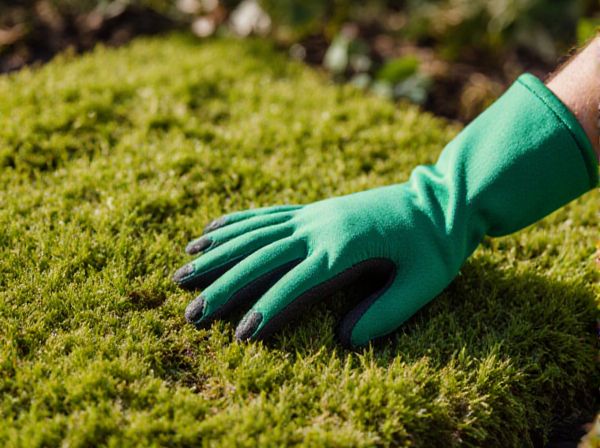
Moss Lawn vs Turf Lawn Illustration
Moss lawns provide a lush, low-maintenance alternative to traditional turf lawns, thriving in shady, moist environments where grass often struggles. They require less water and no mowing, making them eco-friendly and suitable for sustainable landscaping. Turf lawns, while offering a uniform and classic green appearance, demand regular watering, fertilizing, and mowing to maintain their vibrant look.
Table of Comparison
| Feature | Moss Lawn | Turf Lawn |
|---|---|---|
| Water Usage | Low; thrives in shade and damp conditions | High; requires regular irrigation |
| Maintenance | Minimal; no mowing needed | Moderate to High; mowing, fertilizing required |
| Durability | Moderate; prone to damage under heavy foot traffic | High; withstands frequent use |
| Environmental Impact | Eco-friendly; supports biodiversity, absorbs carbon | Less eco-friendly; synthetic turf can cause heat island effect |
| Appearance | Natural, soft, green texture | Uniform, clean-cut look |
| Installation Cost | Low to Moderate | Moderate to High |
| Lifespan | Long-lasting if well-maintained | 10-15 years for synthetic turf |
Introduction to Moss Lawns and Turf Lawns
Moss lawns thrive in shaded, moist environments with minimal maintenance, providing a soft, green carpet that requires no mowing or fertilizing. Turf lawns, composed of grasses like Kentucky bluegrass or fescue, demand regular watering, mowing, and fertilization to maintain a dense, uniform appearance. Moss lawns offer sustainable, eco-friendly alternatives to traditional turf lawns, especially in areas challenging for grass growth.
Key Differences Between Moss and Turf Lawns
Moss lawns require significantly less water and maintenance compared to turf lawns, thriving in shady, acidic, and compacted soils where grass often fails. Turf lawns demand regular mowing, fertilization, and high water usage to maintain their dense, uniform appearance, especially in sunny, well-drained areas. Unlike turf, moss does not withstand heavy foot traffic but excels in erosion control and carbon sequestration, making it an eco-friendly alternative for specific landscape conditions.
Climate and Soil Requirements
Moss lawns thrive in cool, shaded, and humid climates with acidic, compact, and nutrient-poor soils, making them ideal for regions with consistent moisture and low foot traffic. Turf lawns prefer well-drained, fertile soils in temperate to warm climates with ample sunlight and moderate moisture, supporting dense and resilient grass growth. Understanding these distinct climate and soil requirements is essential for sustainable landscape management and selecting the appropriate lawn type.
Maintenance Needs Compared
Moss lawns require significantly less maintenance than turf lawns, thriving in shaded, damp environments with minimal mowing or fertilizing. Turf lawns demand frequent mowing, watering, and fertilizing to maintain their lush appearance, increasing time and resource investment. Choosing moss reduces the need for pesticides and irrigation, promoting eco-friendly lawn care.
Water Conservation and Sustainability
Moss lawns require significantly less water than turf lawns, making them an ideal choice for water conservation in drought-prone regions. Unlike turf grass, moss thrives without regular irrigation, fertilizers, or pesticides, reducing environmental impact and promoting sustainable landscaping. Adopting moss lawns supports biodiversity by providing a habitat for microfauna while minimizing carbon footprint compared to traditional turf maintenance.
Aesthetic Appeal and Design Flexibility
Moss lawns offer a lush, velvety texture with a rich green hue that thrives in shaded, moist environments, creating a serene and naturalistic aesthetic often sought in Japanese garden designs. Turf lawns provide a uniform, vibrant green surface ideal for active outdoor spaces, offering greater design flexibility with various grass species suitable for diverse climates and maintenance levels. The choice between moss and turf significantly impacts landscape aesthetics, where moss emphasizes tranquility and subtle beauty, while turf supports versatility and traditional lawn appearance.
Environmental Impact and Biodiversity
Moss lawns require significantly less water and no chemical fertilizers or pesticides, reducing environmental pollution compared to turf lawns that often demand intensive maintenance. Moss supports higher biodiversity by providing habitat for microfauna and enhancing soil quality, whereas turf lawns typically support limited wildlife due to their monoculture nature. Choosing moss lawns promotes sustainable landscaping by conserving water, decreasing carbon footprint, and fostering ecological balance.
Cost and Installation Considerations
Moss lawns typically cost less upfront since they require minimal soil preparation and no mowing equipment, making installation straightforward in shaded, moist environments. Turf lawns demand higher expenses for soil grading, seed or sod purchase, irrigation systems, and ongoing maintenance like mowing and fertilization. Installation time for moss is shorter due to its ability to spread rapidly in suitable conditions, whereas turf lawns require weeks to establish a dense, uniform cover.
Common Problems and Solutions
Moss lawns often face challenges such as poor drainage, excessive shade, and soil acidity, which can be managed by improving airflow, adjusting soil pH, and selecting shade-tolerant moss species. Turf lawns commonly suffer from issues like weed invasion, pest damage, and drought stress, with solutions including regular mowing, integrated pest management, and efficient irrigation systems. Both lawn types benefit from proper site assessment and tailored maintenance practices to enhance their health and appearance.
Choosing the Right Lawn for Your Landscape
Moss lawns offer a low-maintenance, eco-friendly alternative to traditional turf lawns, thriving in shady, moist environments with minimal water and fertilizer requirements. Turf lawns, while requiring more frequent mowing and irrigation, provide a durable, lush surface ideal for heavy foot traffic and solar exposure. Selecting the right lawn depends on your landscape's sunlight, soil conditions, and intended use, balancing sustainability with aesthetic and functional needs.
Moss Lawn vs Turf Lawn Infographic

 gardendif.com
gardendif.com